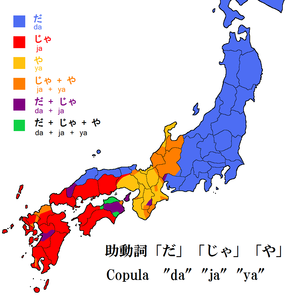List of Japanese dialects

The Japanese language has numerous dialects , which was favored by the geographic features of the country. Not only is the country stretched into a 2000 km long archipelago of four main islands and a few thousand small ones, a few large fertile plains (including the Kantō Plain , Kansai Plain ) are separated from each other by mountain ranges that make up almost eighty percent of the land area. This created a series of language islands.
The scientific name for dialects in Japanese is hōgen ( 方言 ). There is also namari ( 訛 ) for different pronunciations or accents and -ben ( 弁 ) for the dialect of a region. The Japanese dialects have a high variance, so that z. B. the communication of speakers of the Tsugaru dialect in the north and the Kagoshima dialect in the south is not possible. The standard language is the dialect of Edo ( Tokyo ). Related to the southern Japanese dialects are the Ryūkyū languages , which together with Japanese form the family of Japanese languages .
The dialects are grouped into East Japanese dialects ( 東 日本 方言 Higashi-Nihon hōgen or 東部 方言 Tōbu hōgen ) and West Japanese dialects ( 西 日本 方言 Nishi-Nihon hōgen or 西部 方言 Seibu hōgen ). The dividing line between the two groups is called the Itoigawa Lake Hamana Line.
The Ainu language is not related to Japanese .
East Japanese
- Hokkaidō dialect ( 北海道 方言 )
- Tōhoku dialect (s) ( 東北 方言 )
- Kantō dialects ( 東 関 東方 言 )
- West Kantō dialect ( 西 関 東方 言 )
- Hachijō -dialect ( 八丈 方言 ): spoken on some remote islands such as Aogashima , Hachijō-jima , and the Daitō Islands , still strongly colored by Old-East Japanese
- Chūbu dialects ( 中部 方言 )
Western Japanese
- Hokuriku dialects ( 北 陸 方言 )
-
Kansai dialect (s) / Kinai dialects ( 関 西 弁 / 近畿 方言 )
- Ōmi dialect ( 近 江 弁 )
- Kyōto dialect ( 京都 弁 )
- Maizuru dialect ( 舞 鶴 弁 )
- Tanba dialect ( 丹波 弁 )
-
Ise dialect ( 伊 勢 弁 )
- Shima dialect ( 志摩 弁 )
- Iga dialect ( 伊 賀 弁 )
- Ōsaka dialect ( 大阪 弁 )
- Kobe dialect ( 神 戸 弁 )
- Banshū dialect ( 播 州 弁 )
-
Nara dialect ( 奈良 弁 ), also Yamato dialect ( 大 和 弁 )
- Totsukawa dialect ( 十津川 弁 )
- Kishū dialect ( 紀 州 弁 )
- Awaji dialect ( 淡 路 弁 )
- Tōkai-Tōsan dialects ( 東海 東山 方言 )
- Shikoku dialects ( 四 国 方言 )
- Unpaku dialects ( 雲 伯 方言 )
- Chūgoku dialects ( 中国 方言 )
Kyushu dialects
- Hō nichi dialects ( 豊 日 方言 )
- Hi chiku dialects ( 肥 筑 方言 )
- Satsu gū dialects ( 薩 隅 方言 ), Kagoshima dialect ( 鹿 児 島 弁 )
literature
- Kay Genenz: Dialects . In: Bruno Lewin (Ed.): Language and writing of Japan . EJ Brill, 1989, ISBN 90-04-08775-3 , ISSN 0921-5239 , pp. 63-97 .
Individual evidence
- ↑ Kay Genenz: Dialects . In: Bruno Lewin (Ed.): Language and writing of Japan . EJ Brill, 1989, ISBN 90-04-08775-3 , ISSN 0921-5239 , pp. 63 ( digitized in Google book search).

